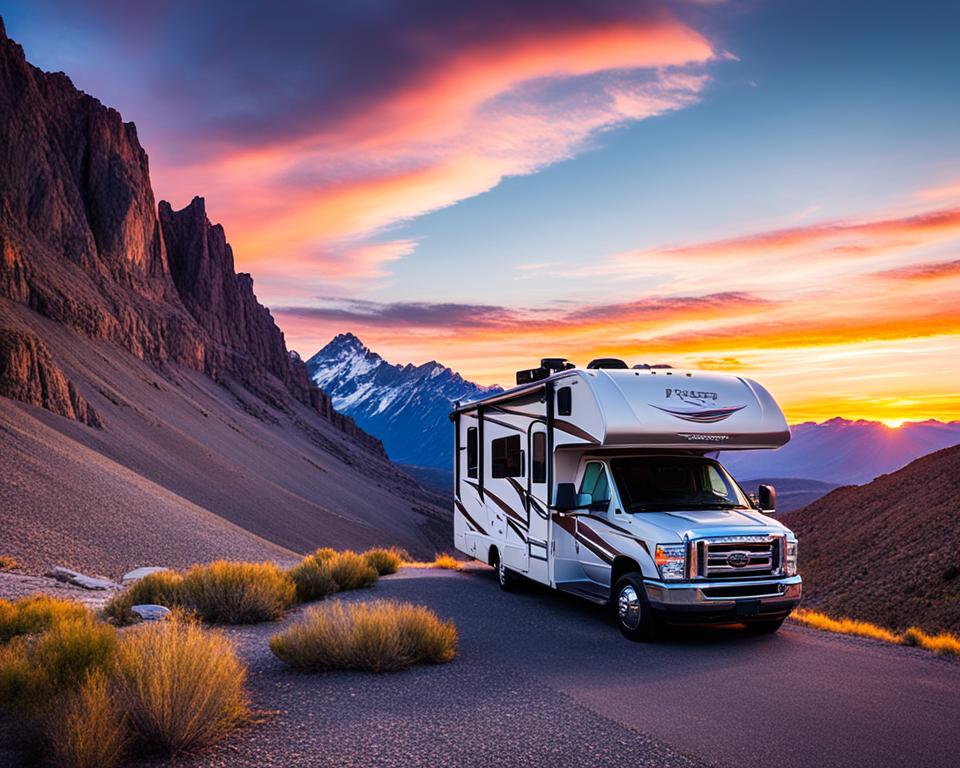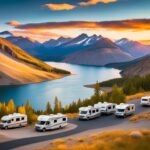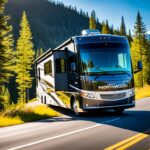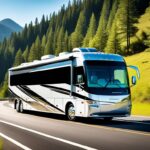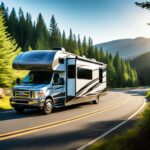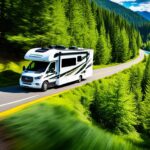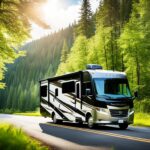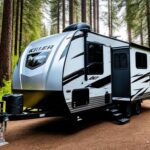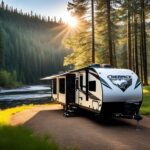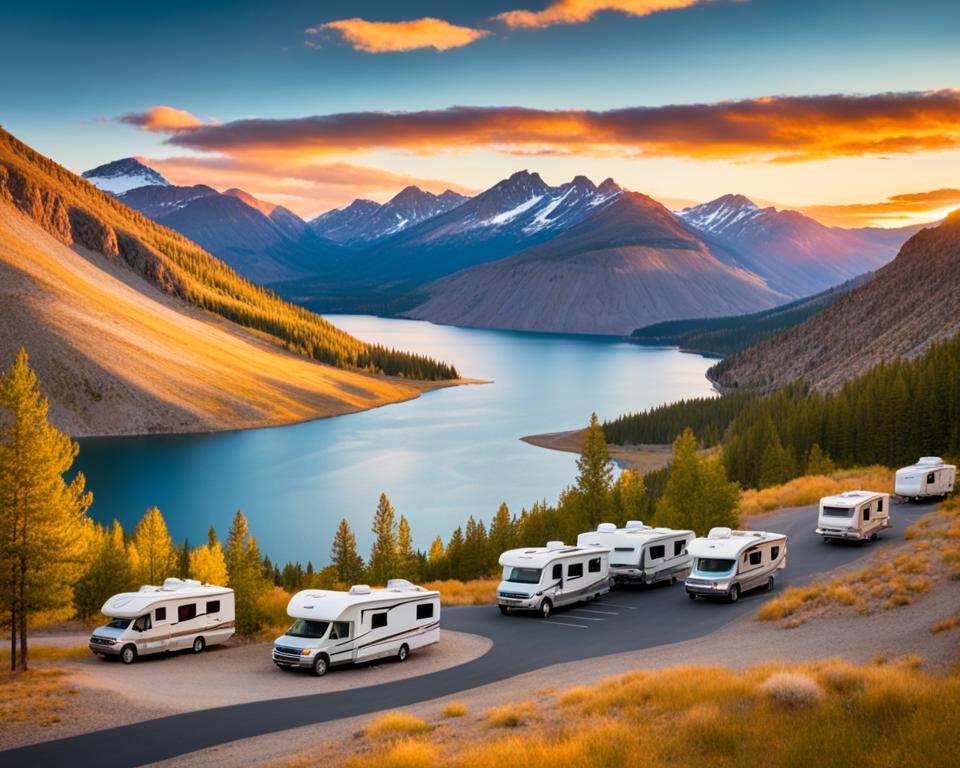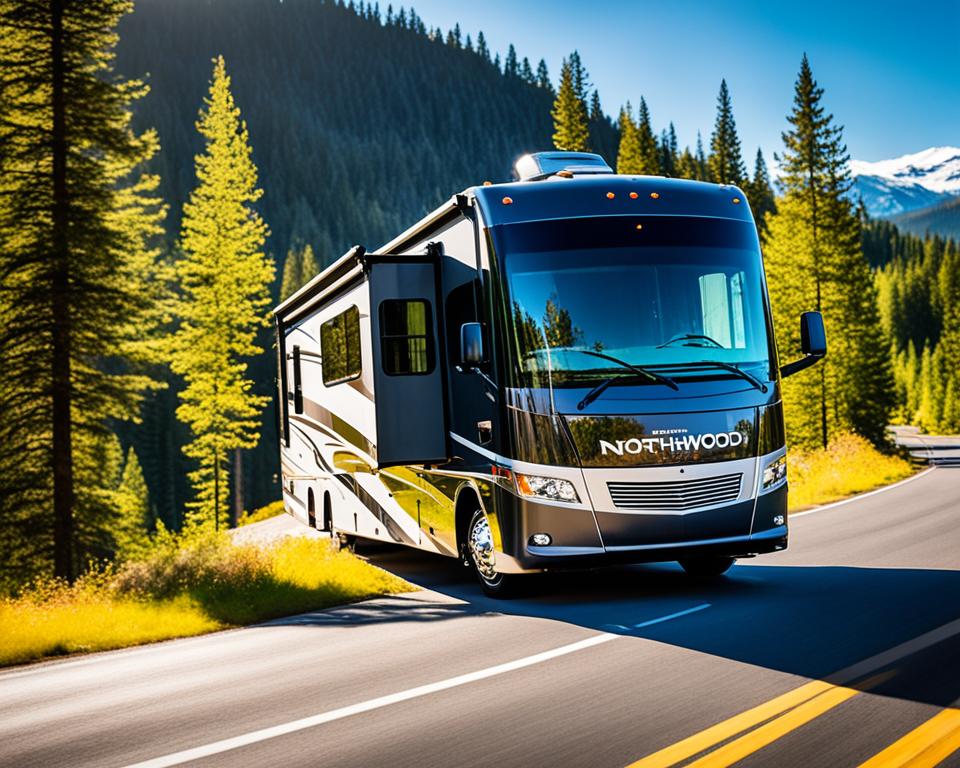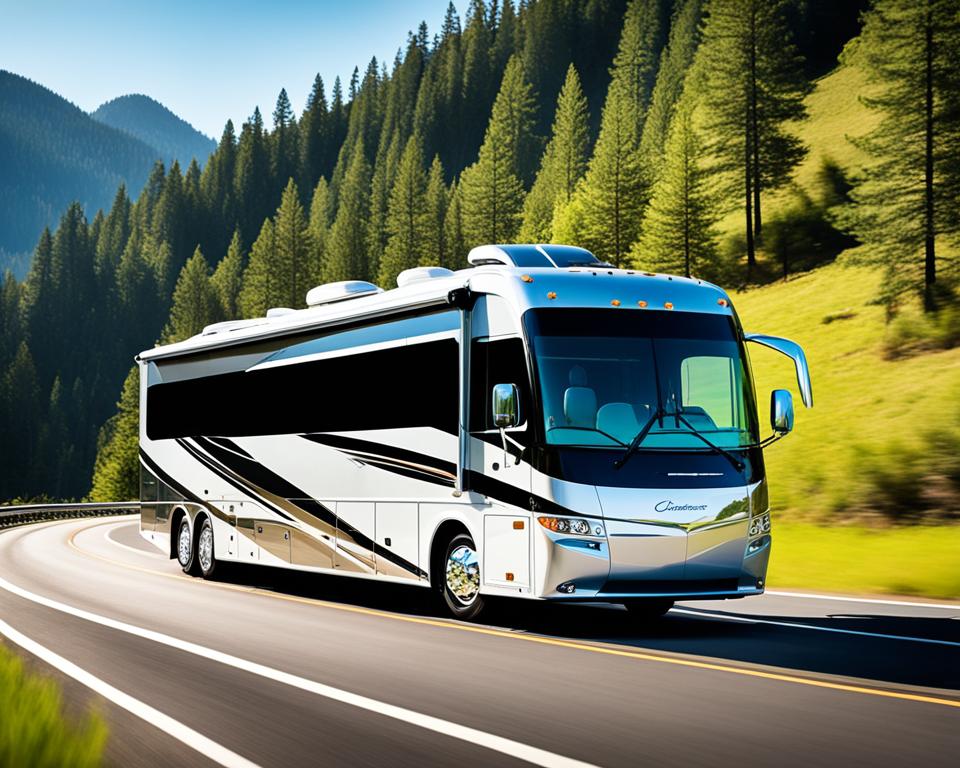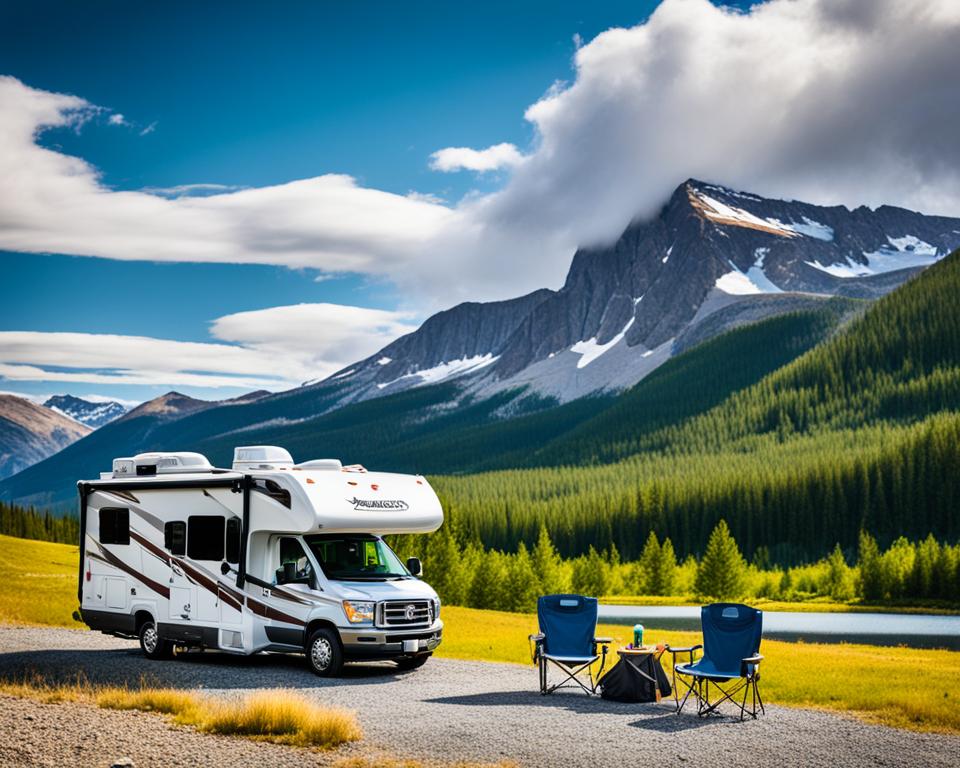Embark on solo RV travel adventures and discover the freedom of exploring the open road at your own pace. Whether you’re an experienced RV traveler or a newbie, solo RV travel offers a unique opportunity for self-discovery, connection with nature, and embracing the thrill of the unknown.
Solo RV travel allows you to escape the confines of everyday life and create your own itinerary, with the freedom to change plans as you go. It’s a chance to disconnect from the digital world and reconnect with yourself, while enjoying the comforts of home on wheels.
In this article, we will provide you with practical tips and insights to enhance your solo RV travel experiences. From safety precautions to choosing destinations, planning routes, packing smart, staying connected, and prioritizing safety, we’ve got you covered.
Key Takeaways:
- Embarking on solo RV travel adventures offers freedom, self-discovery, and connection with nature.
- Enjoy the comforts of home while exploring the open road at your own pace.
- We will provide practical tips on safety precautions, choosing destinations, planning routes, packing smart, staying connected, and prioritizing safety.
Solo RV Travel Safety Tips
While embarking on solo RV travel adventures can be an incredible way to explore the great outdoors, it’s important to prioritize safety on the road. By taking a few simple precautions, you can ensure a secure and enjoyable journey. Here are some essential solo RV travel safety tips:
- Read camping reviews: Before choosing a campground or RV park, take the time to read reviews and gather information about the area. Look for reviews that specifically mention safety measures and the overall experience of solo travelers.
- Plan where to park: When arriving at your destination, choose well-lit and populated areas to park your RV. Aim for campgrounds with security features, such as surveillance cameras or onsite security personnel.
- Trust your instincts: If you ever feel unsafe or uncomfortable in a particular location, trust your instincts and leave. It’s always better to prioritize your well-being and find an alternative camping spot.
- Share your location and plans: Before setting off on your solo RV adventure, inform trusted family members or friends about your itinerary, including where you plan to stay and your estimated arrival and departure dates. Regularly check in with them to keep them informed of your whereabouts.
- Avoid sharing your location publicly: While social media can be a great platform to share your travel experiences, it’s important to avoid broadcasting your exact location publicly. Be mindful of who can access this information to maintain your privacy and security.
By following these solo RV travel safety tips, you can enhance your overall safety and peace of mind during your solo adventures. Remember, prioritizing safety is key to enjoying a worry-free journey.
Choosing Safe and Suitable Destinations
When embarking on solo RV travel adventures, it’s crucial to select destinations that prioritize safety and cater to the needs of solo travelers. This section will highlight the importance of choosing safe and RV-friendly destinations, allowing solo adventurers to explore with peace of mind. Whether you prefer serene natural landscapes or vibrant cityscapes, there are plenty of solo travel destinations to choose from.
RV-Friendly National Parks
National parks are excellent destinations for solo RV travel due to their well-maintained campgrounds and RV-friendly amenities. These parks provide a safe environment for solo travelers, with designated RV campsites that offer the convenience of hookups for electricity, water, and sewage. Exploring national parks allows you to immerse yourself in nature, hike scenic trails, and witness breathtaking landscapes.
“National parks are a solo traveler’s paradise, offering stunning natural beauty and opportunities for self-reflection.”
Well-Populated Campgrounds
Choosing campgrounds with a healthy population of fellow travelers is another way to ensure safety and build connections while on a solo RV adventure. Opting for popular RV parks and campgrounds increases the likelihood of interacting with other like-minded adventurers, creating opportunities for socialization, sharing travel tips, and providing assistance if needed.
Popular Solo Travel Routes
Exploring popular solo travel routes can be a great way to connect with other solo travelers and find camaraderie on the road. These routes often have well-established infrastructure, making them safer and more convenient for solo RV travel. Whether you’re traversing iconic coastal highways, scenic mountain passes, or historic trails, popular solo travel routes offer stunning vistas and unique experiences along the way.
| Solo Travel Route | Description |
|---|---|
| Pacific Coast Highway | Stretching along the scenic California coastline, this route offers breathtaking ocean views and opportunities to explore charming seaside towns. |
| Route 66 | A nostalgic journey through the heart of America, Route 66 takes you through diverse landscapes, quaint towns, and iconic roadside attractions. |
| Blue Ridge Parkway | Winding through the Appalachian Mountains, this route showcases stunning scenic vistas, vibrant fall foliage, and charming southern hospitality. |
| Alaska Highway | An epic adventure to the Last Frontier, the Alaska Highway allows you to soak in the rugged beauty of the Alaska wilderness. |
By choosing safe and suitable destinations for your solo RV travels, you can enjoy the freedom of the open road while ensuring your safety and peace of mind. Remember to conduct thorough research, consider the experiences of other solo travelers, and use reputable resources to select destinations that align with your preferences and travel style.
Planning Your Route
When embarking on a solo RV travel adventure, careful route planning is vital for a safe and efficient journey. Consider your vehicle’s capabilities, your preferred pace, and your driving stamina to determine an itinerary that suits your needs. Take into account factors such as road conditions, weather forecasts, and any potential road closures. Having a contingency plan will ensure you’re prepared for unexpected changes along the way.
Before setting off on your solo travel route, it’s essential to research the destinations you plan to visit and consider any RV travel route considerations specific to those areas. Take note of RV-friendly campsites and facilities, as well as any regulations or restrictions that may apply. This will help you navigate the route smoothly and avoid any potential issues along the way.
Whether you prefer a leisurely road trip or a more adventurous journey, it’s crucial to assess your driving stamina. Take frequent breaks during long drives to rest and recharge. It’s important to prioritize your safety and well-being on the road.
To help you plan your route effectively, here are some key considerations:
- Research and select destinations that align with your travel preferences and interests.
- Check weather forecasts and road conditions for each location you plan to visit.
- Consider the distance and driving time between destinations to ensure a realistic and manageable itinerary.
- Have a backup plan in case of unforeseen circumstances, such as road closures or changes in weather conditions.
- Make use of navigation tools, whether it’s GPS devices, map apps, or paper maps, to navigate your desired route.
| Considerations | Solo Travel Route Planning | RV Travel Route Considerations | Road Trip Planning | Driving Stamina |
|---|---|---|---|---|
| Research destinations and choose suitable routes. | ✔️ | ✔️ | ✔️ | |
| Check weather conditions and road closures. | ✔️ | ✔️ | ||
| Assess driving stamina and plan for breaks. | ✔️ | ✔️ | ✔️ | |
| Create backup plans for unexpected circumstances. | ✔️ | ✔️ | ✔️ | |
| Use navigation tools to help guide the route. | ✔️ | ✔️ | ✔️ |
By following these guidelines and considering your personal preferences and abilities, you can ensure a smooth and enjoyable solo RV travel adventure. Plan your route wisely, taking into account the specific considerations for solo travel, RV travel, road trips, and your own driving stamina.
Packing Smart for Solo RV Travel
When embarking on a solo RV travel adventure, packing smart is essential to ensure you have everything you need while maximizing your limited space. Follow these solo RV travel packing tips to streamline your packing process and make the most of your journey.
Essential RV Travel Gear
Before you hit the road, make sure you have the following essential RV travel gear:
- Collapsible cookware: Save space in your RV kitchen by opting for collapsible cookware that can be easily stored.
- Multi-purpose tools: Carry versatile tools such as a Swiss army knife or a multi-tool to handle various tasks.
- First-aid kit: Be prepared for any minor injuries or medical emergencies with a well-stocked first-aid kit.
Space-Saving Equipment
Maximize your storage space by investing in space-saving equipment:
- Compression bags: Pack your clothing and bedding in compression bags to reduce their size and make more room in your RV.
- Collapsible furniture: Opt for collapsible chairs and tables that can be easily folded and stored when not in use.
- Hanging organizers: Utilize the vertical space in your RV by using hanging organizers to keep your belongings organized and easily accessible.
RV Breakdown Essentials
Though we hope for smooth travels, it’s important to be prepared for unexpected RV breakdowns. Make sure you have the following essentials in case of emergencies:
- Toolkit: Pack a basic toolkit with essential tools and spare parts to handle common repairs on the road.
- Tire repair kit: Be prepared for flat tires with a tire repair kit that includes a tire plug, patch kit, and air compressor.
- Jumper cables: Carry jumper cables to jump-start your RV battery or help other stranded travelers.
By packing smart and focusing on the essentials, you can optimize your solo RV travel experience. Remember to prioritize space-saving equipment and prepare for potential breakdowns to ensure a safe and enjoyable journey.
| Essential RV Travel Gear | Space-Saving Equipment | RV Breakdown Essentials |
|---|---|---|
| Collapsible cookware | Compression bags | Toolkit |
| Multi-purpose tools | Collapsible furniture | Tire repair kit |
| First-aid kit | Hanging organizers | Jumper cables |
Staying Connected on Solo RV Adventures
Even when traveling solo, staying connected with the outside world is important. Whether it’s for safety, communication, or sharing your incredible experiences, having reliable means of staying connected enhances your solo RV travel adventures. This section provides valuable insights on how to stay connected while on your solo RV journey, ensuring you have peace of mind and the ability to connect with loved ones whenever needed.
Bringing a Mobile Phone or Satellite Phone
One essential item to have with you on your solo RV adventure is a mobile phone. A mobile phone allows you to stay in touch with family and friends, access important information, and call for help in case of an emergency. Before embarking on your trip, make sure your mobile phone is fully charged and has a good network coverage plan to ensure you can make calls and use mobile data while on the road.
Alternatively, for more remote and off-the-grid locations, having a satellite phone can provide a reliable means of communication. Satellite phones use satellite networks instead of traditional cell towers, allowing you to make calls and send messages even in areas with no mobile network coverage. Consider renting or purchasing a satellite phone if you plan on exploring remote areas during your solo RV journey.
Remember to keep your mobile phone or satellite phone charged and within easy reach at all times. It’s also advisable to invest in a sturdy phone mount or holder for your RV, ensuring your device remains secure while you’re on the move.
Ensuring a Reliable Internet Connection
Having a reliable internet connection is crucial for staying connected while on your solo RV adventures. Whether you need to access maps and navigation apps, research destinations, or stay connected with work or social media, a stable internet connection is essential.
One option is to rely on mobile data for internet access. Ensure you have a suitable data plan with sufficient coverage for your travel routes. However, keep in mind that signal strength can vary depending on your location, especially in remote areas. It’s a good idea to invest in a signal booster or mobile hotspot device to enhance your internet connection’s reliability and range.
Another option is to look for campgrounds or RV parks that offer Wi-Fi access. Many campsites provide Wi-Fi access as part of their amenities, allowing you to connect your devices and stay connected online. However, be aware that the speed and reliability of campsite Wi-Fi can vary, so it’s always wise to have a backup plan in case the connection is slow or not available.
Sharing Your Location with Loved Ones
While solo RV travel offers a sense of freedom and independence, it’s essential to keep loved ones informed about your whereabouts for safety purposes. Share your location with trusted family members or friends, especially if you plan to venture into remote or unfamiliar areas.
Modern smartphones have built-in features that allow you to share your location in real-time. Use apps like Google Maps or Find My Friends to share your location with selected contacts. This way, your loved ones can keep track of your journey and be alerted if they sense any trouble.
By staying connected through mobile phones or satellite phones, ensuring a reliable internet connection, and sharing your location with loved ones, you can have peace of mind on your solo RV adventures. These communication tools and practices not only enhance your safety but also allow you to share your incredible journey with those who care about you.
Prioritizing Safety on Solo RV Travel
Solo RV travel can be an exciting adventure, but it’s essential to prioritize safety throughout your journey. By taking necessary precautions and following safety measures, you can ensure a secure and enjoyable solo RV travel experience.
Maintaining Vehicle Condition
Regular RV maintenance and servicing are vital for a safe and hassle-free trip. Before hitting the road, make sure to check the condition of your vehicle, including tires, brakes, lights, and fluid levels. Keeping up with routine maintenance reduces the risk of breakdowns and ensures optimal performance.
Adhering to Traffic Rules
Obeying traffic rules is crucial for your safety and the safety of others on the road. Follow speed limits, avoid distractions while driving, and use turn signals to indicate your intentions. Remember to maintain a safe distance from other vehicles and be aware of changing road conditions.
Wearing Seatbelts
Always wear your seatbelt when driving or riding in an RV. Seatbelts significantly reduce the risk of injuries in the event of an accident or sudden stops. It’s essential to remind all passengers to buckle up, including children and pets.
Considering Security Measures for RVs
Protecting your RV against theft and unauthorized access is an important aspect of solo RV travel. Consider installing security measures such as alarms, GPS trackers, or wheel locks to deter potential thieves. Additionally, keep valuables out of sight and secure your RV when leaving it unattended.
In summary, prioritizing safety on solo RV travel involves maintaining vehicle condition, adhering to traffic rules, wearing seatbelts, and considering security measures for your RV. By taking these precautions, you can ensure a safe and enjoyable journey on the open road.
| Safety Measures | Description |
|---|---|
| Regular Maintenance | Ensure the RV is in good condition by performing regular maintenance checks and servicing. |
| Obey Traffic Rules | Familiarize yourself with local traffic laws and regulations and follow them diligently. |
| Seatbelt Usage | Always wear your seatbelt while driving or riding in the RV to reduce the risk of injuries. |
| Security Measures | Install alarms, GPS trackers, or wheel locks to enhance the security of your RV. |
Solo Camping Safety in Texas
When it comes to solo camping in Texas, prioritizing safety is key. Whether you’re a seasoned solo traveler or new to the solo camping experience, taking precautions and being well-prepared will enhance your enjoyment and peace of mind. Here are some essential tips to ensure a safe and enjoyable solo camping adventure in the Lone Star State.
Choosing a Safe Campsite
Selecting a safe campsite is crucial for solo camping in Texas. Look for well-populated camping areas where you can be surrounded by other campers, creating a sense of safety and community. Avoid secluded or remote locations that may increase vulnerability. Prioritize campsites with good lighting, well-defined boundaries, and reliable cell phone reception.
Camping Gear Essentials
When packing for solo camping in Texas, it’s important to bring along the essential gear that will keep you comfortable and prepared. Consider the following camping gear essentials:
- Sturdy tent or hammock with bug netting
- Sleeping bag suitable for the expected weather conditions
- Cooking equipment, such as a portable stove or grill
- First aid kit with necessary supplies
- Extra clothing layers for unpredictable weather
- Water purification system or enough bottled water
- Navigation tools, including a map and compass
- Flashlight or headlamp with extra batteries
- Personal safety items, like a whistle and pepper spray
Packing only what you need will help you stay organized and ensure that you have space for important safety items. Remember to double-check your gear before heading out to the campsite.
Managing Changing Weather Conditions
Weather in Texas can be unpredictable, so being prepared for changing conditions is essential. Check the weather forecast before you set off and pack appropriate clothing and gear, such as rain gear, warm layers, and sun protection. Have a contingency plan in case of severe weather events, such as storms or heatwaves.
Remember, solo camping in Texas can be a wonderful experience when safety is prioritized. By choosing a safe campsite, packing the right gear, and staying prepared for changing weather conditions, you can fully enjoy the natural beauty and serenity that Texas has to offer.
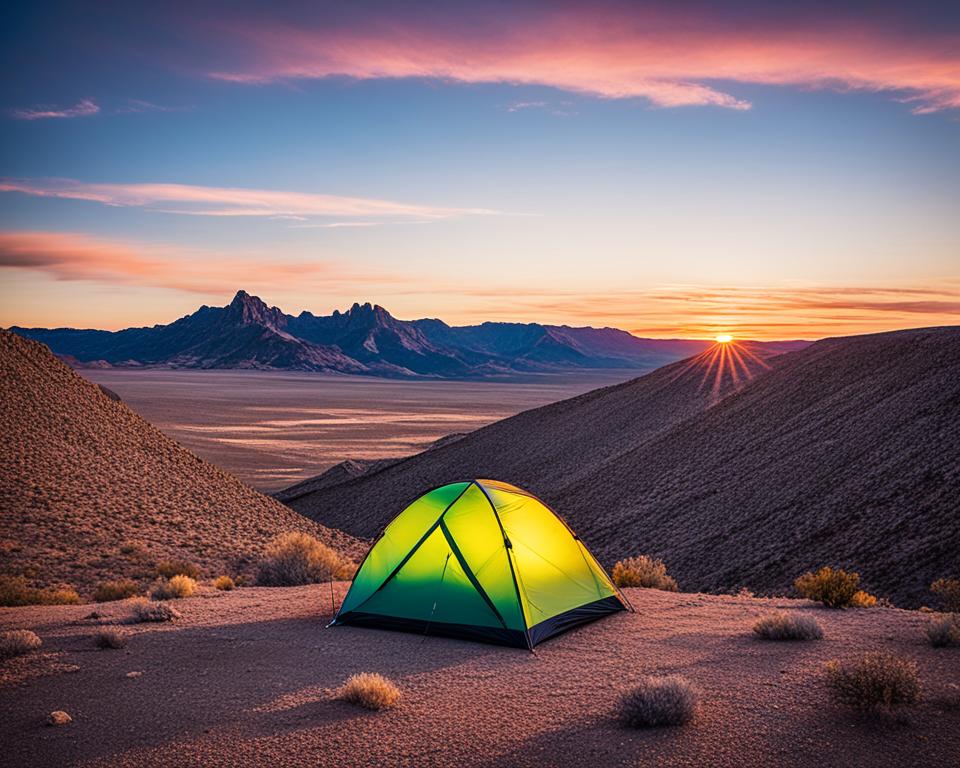
Stay tuned for the next section where we will discuss how to maintain a low profile while solo camping, blending in with nature, and avoiding excessive displays.
Maintaining a Low Profile while Solo Camping
When embarking on a solo camping adventure, it’s important to maintain a low profile to ensure your safety and minimize unwanted attention. Blending in with nature and avoiding excessive displays can help create a sense of inconspicuousness. Here are some tips to help you stay under the radar:
- Blend in with nature: Choose clothing and gear that matches the natural surroundings. Opt for neutral colors like earthy tones and camouflage patterns that allow you to seamlessly blend in with the environment.
- Avoid flashy gear: Inconspicuous camping gear is key to maintaining a low profile. Opt for gear that is practical, functional, and doesn’t attract unnecessary attention. Avoid excessive branding or flashy designs that may draw unwanted eyes.
- Maintain a tidy campsite: Keep your campsite organized and clean. A cluttered campsite with excessive displays can attract attention and potentially invite unwanted visitors. Pack your belongings neatly and ensure that your campsite appears inconspicuous.
Remember, solo camping is about immersing yourself in nature while respecting the environment and leaving no trace behind. By blending in with nature and avoiding excessive displays, you can enjoy a safe and inconspicuous camping experience.
Benefits of Maintaining a Low Profile
Maintaining a low profile while solo camping offers several benefits:
“When you blend in with nature and avoid drawing attention, you’re more likely to experience a deeper connection with the surroundings. It allows you to observe wildlife from a distance without disturbing their natural behavior.”
– Nature enthusiast and solo camper, Rachel Thompson
| Benefits of Maintaining a Low Profile |
|---|
| Enhanced safety and security |
| Minimized risk of unwanted attention |
| Improved wildlife observation opportunities |
| Respect for the natural environment |
Essential Gear for Solo Campers
Packing the right gear is crucial for a successful solo camping trip. Whether you’re embarking on a weekend getaway or a lengthy adventure, having the right essentials will ensure you have a comfortable and enjoyable experience. Here are some key items to consider:
Versatile Clothing
When it comes to clothing, pack versatile pieces that can be layered and adapted to different weather conditions. Opt for moisture-wicking and quick-drying materials to stay comfortable throughout your trip. Don’t forget to pack a warm jacket or sweater for cooler nights.
Shelter
Your shelter is your home away from home, so choose a lightweight and easy-to-setup tent or hammock. Consider the weather conditions you’ll be camping in and select a shelter that provides adequate protection. If you’re in an area with mosquitoes or bugs, don’t forget to pack a mosquito net.
Cooking Essentials
Preparing meals while camping is part of the adventure, so pack compact cooking equipment that won’t take up too much space in your backpack or RV. Look for space-saving options such as collapsible pots and pans, a portable stove or grill, and utensils that can be easily packed away.
Hydration Essentials
Staying hydrated is essential during your camping trip, so be sure to pack reusable water bottles or hydration reservoirs to ensure you have a steady supply of clean drinking water. Additionally, consider bringing water purification tablets or a lightweight water filter for emergencies.
Navigation Tools
When exploring the great outdoors, navigation tools are essential for staying on track. Carry a reliable compass, maps of the area, and a GPS device or smartphone with offline maps. Familiarize yourself with the routes and trails before setting off to ensure a safe and successful journey.
| Item | Description |
|---|---|
| Versatile Clothing | Moisture-wicking and quick-drying materials, warm jacket or sweater |
| Shelter | Lightweight tent or hammock, mosquito net |
| Cooking Essentials | Collapsible pots and pans, portable stove or grill, utensils |
| Hydration Essentials | Reusable water bottles or hydration reservoirs, water purification tablets or filter |
| Navigation Tools | Compass, maps, GPS device or smartphone with offline maps |
Remember, when packing essential gear, focus on being self-sufficient without overburdening yourself. Choose space-saving camping equipment and pack only what you truly need. With the right gear, you’ll be well-prepared to embark on your solo camping adventure.
Preparing for Changing Conditions in Solo Camping
When embarking on a solo camping adventure, it’s crucial to be prepared for changing weather conditions. Mother Nature can be unpredictable, and being equipped to adapt to various climates ensures a safe and enjoyable experience. Here are some essential tips to help you prepare for changing weather conditions during your solo camping trip.
Check the Weather Forecast
Before heading out on your solo camping excursion, always check the weather forecast for your destination. This will give you valuable insights into what conditions to expect and help you plan accordingly. Pay attention to temperature fluctuations, precipitation chances, wind speeds, and any severe weather warnings. Having a clear understanding of the forecast will allow you to pack the right gear and make any necessary adjustments to your plans.
Pack Adaptable Gear
Having adaptable gear is key to staying comfortable in changing weather conditions during solo camping trips. Opt for versatile clothing that can be layered to adjust to varying temperatures. Pack a quality waterproof and windproof jacket to shield yourself from unexpected rain or chilly winds. Additionally, bring a reliable tent that can withstand different weather conditions, such as strong winds or heavy rain. Prioritize gear that is lightweight, compact, and easily adjustable to accommodate changing weather.
Create Contingency Plans
While you hope for ideal camping conditions, it’s essential to have contingency plans in case of unexpected weather events. Prepare alternative camping spots that provide shelter or higher ground if your original campsite becomes uninhabitable due to flooding or other natural occurrences. Research nearby indoor accommodations or camping areas with facilities that you can seek refuge in if needed. By having backup options, you’ll be better equipped to adapt to changing conditions and ensure your safety.
Stay Informed and Flexible
Throughout your solo camping trip, stay informed about any weather updates or changes in conditions. Listen to local news or check reliable weather apps and websites to keep yourself updated. If the weather takes a turn for the worse, consider altering your plans and seeking shelter until conditions improve. Flexibility is key when dealing with changing weather, and prioritizing your safety should always be the top concern.
“Being prepared for changing weather conditions is crucial for a safe and enjoyable solo camping experience. By checking the weather forecast, packing adaptable gear, creating contingency plans, and staying informed and flexible, you’ll be well-equipped to handle whatever Mother Nature throws your way.”
Conclusion
In conclusion, solo RV travel adventures and solo camping offer a one-of-a-kind experience that is both liberating and empowering. It allows individuals to embark on a journey of self-discovery, embracing the solitude and immersing themselves in the beauty of nature. The rewards and benefits of solo travel are countless, from the freedom to choose your own pace to the flexibility in exploring breathtaking destinations.
Throughout the journey, it is crucial to prioritize safety. By following the safety tips and precautions outlined in this article, solo RV travelers can ensure a secure and worry-free trip. From selecting safe destinations to keeping a low profile, every step should be taken to protect oneself and create a sense of security.
We encourage you to embrace the solo RV travel experience and share your thoughts and personal experiences in the comments section below. Solo travel adventures are about embracing new horizons, immersing oneself in nature, and finding inner strength. So pack your bags, hit the road, and embark on an unforgettable solo RV travel adventure!
FAQ
What are some safety tips for solo RV travel?
Safety tips for solo RV travel include reading camping reviews, planning where to park, leaving if you feel unsafe, sharing your location and plans with trusted contacts, and avoiding sharing your whereabouts publicly.
How do I choose safe and suitable destinations for solo RV travel?
To choose safe and suitable destinations for solo RV travel, consider selecting national parks with RV-friendly campsites and other travelers for social interaction and assistance if needed.
What should I consider when planning my route for solo RV travel?
When planning your route for solo RV travel, consider your vehicle’s capabilities, preferred pace, driving stamina, weather conditions, road closures, and have a contingency plan.
What should I pack for solo RV travel?
For solo RV travel, it’s important to pack essentials such as food, water, first-aid supplies, space-saving equipment like collapsible cookware, a toolkit, and spare parts for RV breakdowns.
How can I stay connected while on solo RV adventures?
To stay connected while on solo RV adventures, bring a mobile phone or satellite phone, ensure a reliable internet connection, and share your location with loved ones.
How can I prioritize safety during solo RV travel?
Prioritize safety during solo RV travel by maintaining your vehicle’s condition, adhering to traffic rules, wearing seatbelts, and considering security measures for RVs like alarms or GPS trackers.
What are some safety tips for solo camping in Texas?
Safety tips for solo camping in Texas include choosing safe campsites, prioritizing safety and comfort, and packing only essential gear. Select a well-populated camping area and pack appropriate gear for changing weather conditions.
How can I maintain a low profile while solo camping?
To maintain a low profile while solo camping, blend in with nature, dress in neutral colors, and avoid flashy gear. Keep your campsite tidy and organized, and respect the environment by leaving no trace.
What essential gear should I pack for solo camping?
Essential gear for solo camping includes versatile clothing, a lightweight tent or hammock, compact cooking equipment, hydration essentials, and navigation tools. Be self-sufficient without overburdening yourself.
How can I prepare for changing conditions while solo camping?
To prepare for changing conditions while solo camping, check the weather forecast, pack gear suitable for different conditions, and have contingency plans for unexpected weather events. Adapt to various climates to stay comfortable.

